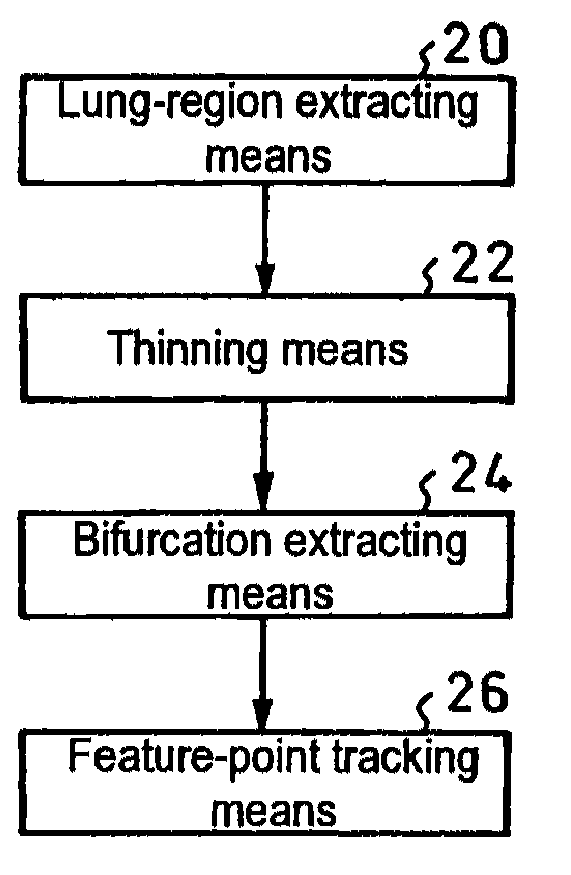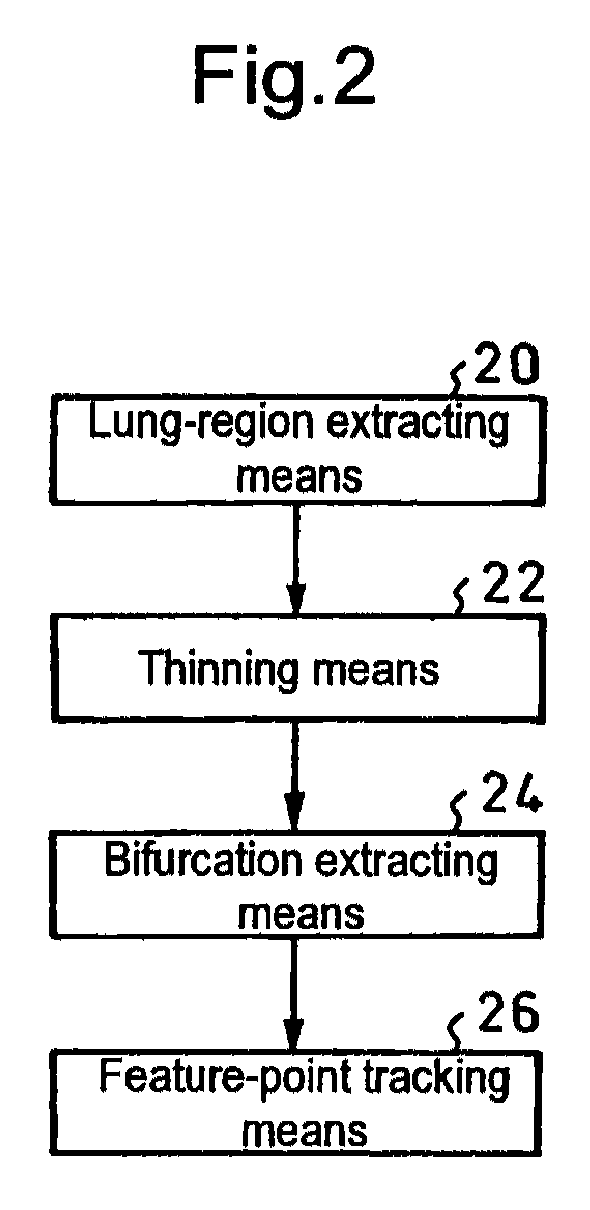Method for quantifying organ motion, apparatus therefor, method for estimating organ position, apparatus therefor, method for irradiating radiation, apparatus therefor, and apparatus for detecting abnormal organ
a technology for organs and motions, applied in the field of methods for quantifying organ motion, can solve the problems of insufficient clinical practice, tumors may be irradiated to an excessively large extent, and the analysis of two-dimensional images is difficult, and achieve the effect of accurately quantifying the motion of an organ
- Summary
- Abstract
- Description
- Claims
- Application Information
AI Technical Summary
Benefits of technology
Problems solved by technology
Method used
Image
Examples
first embodiment
[0055]An apparatus for executing the present invention is that which is constituted as illustrated in FIG. 2 by using, for example, a computer, including lung-region extracting means 20, thinning means 22, bifurcation extracting means 24 and feature-point tracking means 26.
[0056]In the thinning means 22, thresholding is conducted by referring to a certain CT value as a threshold value, and the thus obtained figure having one voxel value is cut. However, if parts such as flesh and bones around a lung are left as a result of the thresholding, these parts are also subjected to the thinning process, and they are substantially greater in volume (voxel number) than the bronchial tubes and blood vessels in the lung, thus resulting in greatly extending the calculation time.
[0057]Therefore, in order to shorten the calculation time and calculate only a necessary lung region, the lung region is first extracted by using the lung-region extracting means 20.
[0058]Specifically, the lung region can...
second embodiment
[0103]Next, an explanation will be made by referring to FIG. 10 for the present invention in which the present invention is used to estimate an organ position so as to irradiate radiation thereto.
[0104]In the present embodiment as well, as illustrated on the left side in FIG. 10, X-ray 37 is irradiated from an X-ray tube 36 to a patient 30 on a bed 34 inside a CT gantry 32. Then, as with the first embodiment, a four-dimensional CT (4D-CT) 40 is used to process an image obtained by an X-ray detector 38, thereby obtaining an image of organ motion (four-dimensional CT image). At this time, for example, movement-information obtaining means 52 is used to simultaneously calculate a respiratory waveform by referring to a respiration sensor 50 fixed on the body surface of the patient 30, thereby obtaining a temporal correlation between them.
[0105]Then, the technology of the first embodiment is used to quantify motions from the four-dimensional CT image at a processing section 60, thereby ob...
third embodiment
[0109]Next, with reference to FIG. 11 (flowchart showing the procedures) and FIG. 12 (schematic diagram), an explanation will be made for the present invention in which the present invention is utilized to detect an abnormal organ.
[0110]In the present embodiment, as the procedures are shown in FIG. 11, displacement vectors for each voxel obtained by the technique of the first embodiment are classified into regions, depending on the vector component concerned, as illustrated in FIG. 12. In other words, as with contour lines obtained depending on the height on each point on a map, regions are classified, depending on the size of components on a vector map, thereby making it possible to extract a region different in displacement. Thereby an abnormal region can be detected.
PUM
 Login to View More
Login to View More Abstract
Description
Claims
Application Information
 Login to View More
Login to View More - R&D
- Intellectual Property
- Life Sciences
- Materials
- Tech Scout
- Unparalleled Data Quality
- Higher Quality Content
- 60% Fewer Hallucinations
Browse by: Latest US Patents, China's latest patents, Technical Efficacy Thesaurus, Application Domain, Technology Topic, Popular Technical Reports.
© 2025 PatSnap. All rights reserved.Legal|Privacy policy|Modern Slavery Act Transparency Statement|Sitemap|About US| Contact US: help@patsnap.com



